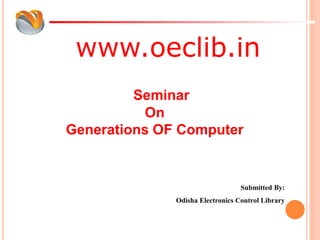
Generations of Computers
- 1. www.oeclib.in Submitted By: Odisha Electronics Control Library Seminar On Generations OF Computer
- 2. CONTENT Introduction What is A Computer First Generation of Computer Features of First Generation Second Generation of Computer Features of Second Generation Third Generation of Computer Features of Third Generation Fourth Generation of Computer Features of Fifth Generation Fifth Generation of Computer Features of Fifth Generation Reference
- 3. INTRODUCTION The history of computer development is often referred to in reference to the different generations of computing devices. Each generation of computer is characterized by a major technological development that fundamentally changed the way computers operate, resulting in increasingly smaller, cheaper, more powerful and more efficient and reliable devices.
- 4. WHAT IS A COMPUTER A computer is an electronic machine that accepts information, stores it until the information is needed, processes the information according to the instructions provided by the user, and finally returns the results to the user.
- 5. FIRST GENERATION - 1940-1956: VACUUM TUBES Used vacuum tubes for circuitry, magnetic drums for memory, and were often enormous, taking up entire rooms. Very expensive , consumed great deal of electricity, generated a lot of heat, which was often the cause of malfunctions. Relied on machine language to perform operations, could solve one problem at a time. Input was based on punched cards and paper tape, and output was displayed on printouts. UNIVAC and ENIAC computers are examples of first-generation computing devices.
- 6. FEATURES OF FIRST GENERATION • Vacuum tube technology • Unreliable • Supported Machine language only • Very costly • Generate lot of heat • Slow Input/output device • Huge size Need of A.C. Non-portable
- 7. SECOND GENERATION - 1956-1963: TRANSISTORS Transistors replaced vacuum tubes allowing computers to become smaller, faster, cheaper, more energy-efficient and more reliable than their first-generation predecessors. Still relied on punched cards for input and printouts for output. Second-generation computers moved from cryptic binary machine language to symbolic, or assembly, languages, which allowed programmers to specify instructions in words. High-level programming languages like COBOL and FORTRAN were used.
- 8. FEATURES OF SECOND GENERATION Use of transistors Reliable as compared to First generation computers Smaller size as compared to First generation computers Generate less heat as compared to First generation computers Consumed less electricity as compared to First generation computers Faster than first generation computers Still very costly A.C. needed Support machine and assembly languages
- 9. THIRD GENERATION - 1964-1971: INTEGRATED CIRCUITS Integrated circuit was used Transistors were miniaturized and placed on silicon chips, called semiconductors, which increased the speed and efficiency of computers. Instead of punched cards and printouts, users interacted through keyboards and monitors and interfaced with an operating system, which allowed the device to run many different applications at one time with a central program that monitored the memory. Computers for the first time became accessible to a mass audience because they were smaller and cheaper than their predecessors.
- 10. FEATURES OF THIRD GENERATION • IC used • More reliable and Faster • Smaller size • Generate less heat • Lesser maintenance • Still costly • A.C. needed • Consumed lesser electricity • Support high-level language
- 11. FOURTH GENERATION - 1971-PRESENT: MICROPROCESSORS Microprocessor were used What in the first generation filled an entire room could now fit in the palm of the hand In 1981 IBM introduced its first computer for the home user, and in 1984 Apple introduced the Macintosh. As these small computers became more powerful, they could be linked together to form networks, which eventually led to the development of the Internet. Fourth generation computers also saw the development of GUIs, the mouse and Hand held devices.
- 12. FEATURES OF FOURTH GENERATION • VLSI technology used • Very cheap • Portable and reliable • Use of PC's • Very small size • Pipeline processing • No A.C. needed • Concept of internet was introduced • Great developments in the fields of networks • Computers became easily available
- 13. FIFTH GENERATION - PRESENT AND BEYOND: ARTIFICIAL INTELLIGENCE Fifth generation computing devices, based on artificial intelligence, are still in development, though there are some applications, such as voice recognition, that are being used today. The use of parallel processing and superconductors is helping to make artificial intelligence a reality. Quantum computation and molecular and nanotechnology will radically change the face of computers in years to come. The goal of fifth-generation computing is to develop devices that respond to natural language input and are capable of learning and self-organization.
- 14. FEATURES OF FIFTH GENERATION • ULSI technology • Development of true artificial intelligence • Development of Natural language processing • Advancement in Parallel Processing • Advancement in Superconductor technology • More user friendly interfaces with multimedia features • Availability of very powerful and compact computers at cheaper rates
- 15. REFERENCES www.google.com www.wikipedia.com www.oeclib.in www.pptplanet.com
- 16. THANKS